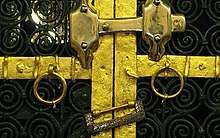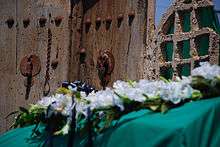Umar at Fatimah's house
Umar at Fatimah's house refers to a confrontation which took place at the home of Fatimah, daughter of the Islamic prophet Muhammad, shortly after the latter's death in 632 CE.
| Part of a series on |
| Islam |
|---|
 |
|
A group, led by the prominent sahaba Umar, went to the house to meet Fatimah's husband Ali and his partisans, with the aim of gaining their allegiance for the newly elected caliph, Abu Bakr. However, this resulted in a standoff between the two parties, the details of which are uncertain.
This event, which has mentions in Shia, Sunni, and western academic books, is also claimed by Shia sources[1] to have led to Fatimah's miscarriage of her son Muhsin ibn Ali,[2][3] as well as her own death shortly after.[4] However, the veracity of this account is disputed, with beliefs being primarily split on sectarian lines between Sunni and Shia denominations.[5]
Background
In the immediate aftermath of the death of Muhammad, a gathering of the Ansar (natives of Medina) took place in the Saqifah (courtyard) of the Banu Sa'ida clan.[6] The general belief at the time was that the purpose of the meeting was for the Ansar to decide on a new leader of the Muslim community from among themselves, with the intentional exclusion of the Muhajirun (migrants from Mecca), though this has since become the subject of debate.[7] Nevertheless, Abu Bakr and Umar, both prominent sahabah of Muhammad, upon learning of the meeting became concerned of a potential coup and hastened there. After a partially heated debate, Abu Bakr was ultimately elected by those gathered as the new head of the Muslim community.[8]
Though his ascension was near-universally accepted, Abu Bakr faced contention as a result of the rushed nature of his election. Several sahabah, most prominent among them being Ali ibn Abi Talib, initially refused to acknowledge his authority.[6] Ali himself may have been reasonably expected to assume leadership, being both cousin and son-in-law to Muhammad.[9] Among the Shia sect of Islam, it is also traditionally held that Ali had previously been designated by Muhammad as his desired heir, though this is subject to dispute.[10] Whether his candidacy for the succession was raised during Saqifah is unknown, though it is not believed to be unlikely.[11]
Event

After the gathering at Saqifa, Umar (who had been among Abu Bakr's advocates) and his supporters were allegedly sent by the new Caliph to Ali's house where Ali, Fatimah and some of their allies were gathered.[12] Several scholars, such as Al-Tabari and Ibn Qutaybah, narrate that Umar threatened to burn the building down if Ali refused to acknowledge Abu Bakr's authority, with Al-Tabari adding that Umar's men beat Ali's friend Zubayr ibn al-Awam.[13][14][15][16] According to the Al-Imama wa al-Siyasa (mistakenly attributed to Ibn Qutaybah),[17] when Umar was informed that Fatimah was inside the house, he responded that her presence made no difference to him.[18][19]
While the historian Al-Baladhuri states that the altercation never became violent and ended with Ali's compliance,[20] and Tabari makes no mention of Fatimah's involvement,[13] some traditions add that Umar and his supporters forcibly entered the house, resulting in Fatimah's miscarriage of her unborn son Muhsin.[21] Twelver Shia sources state that this occurred when Umar forced the front door open, crushing Fatimah behind it and breaking her ribs.[1] However, the Mu'tazilite theologian Ibrahim al-Nazzam narrates that, "Umar hit Fatimah (sa) on the stomach such that the child in her womb died."[22] Alternatively, Ibn Rustam Al-Tabari states that it was a client of Umar's named Qunfudh who caused the miscarriage, having struck her with the sheath of his sword.[23] Other traditions add that Qunfudh had her whipped[24] or had struck her face.[25] The Kitab Sulaym ibn Qays (attributed to Sulaym ibn Qays, but possibly a later creation)[26] concludes the incident with Ali being dragged out of the house with a rope tied around his neck.[27]
Mohammad-Baqer Majlesi, writing in his Bihar al-Anwar, states that Fatimah died soon after due to injuries sustained during the altercation.[4] The aforementioned Al-Imama wa al-Siyasa records that before her death, Fatimah said to Abu Bakr and Umar, "I take Allah and the angels to be my witness that you have not pleased me; on the other hand, you have angered me. When I shall meet the Prophet (S) I will complain about you two."[28] According to Morteza Motahhari, she asked Ali to bury her at night to ensure that none of her enemies participated in her funeral.[29]
Historicity

The events that took place in the house have been the subject of dispute between various accounts, with the versions including violence primarily having Shia origins.[1] Several early historical sources narrate that Fatimah's child Muhsin had died in early childhood rather than being miscarried. Al-Baladhuri, along with Al-Ya'qubi and Al-Masudi, list Muhsin among the children of Fatimah, but without any mention of a miscarriage. Similarly, the Shia theologian Al-Shaykh Al-Mufid, when writing his Kitab al-Irshad, makes no mention of violence in relation to Muhsin's death. The earliest known reference of the miscarriage during the altercation only appears in the 10th century, in Ibn Qulawayh Al-Qummi's Kamil al-ziyarat.[30]
Other sources also add that Fatimah and Abu Bakr had ultimately reconciled,[31] and that she died of illness,[32] with him attending and praying at her funeral.[33] Ali is also believed to have later willingly offered his oath of allegiance to Abu Bakr and gave a praise-filled oration during the latter's funeral.[34] Professor Coeli Fitzpatrick surmises that the story of the altercation reflects the political agendas of the period and should therefore be treated with caution.[21]
See also
References
- Illahi, Mahboob (2018). Doctrine of Terror: Saudi Salafi Religion. FriesenPress. p. 150. ISBN 978-1-5255-2646-6.
- Al-Masudi. Isbaat al-Wilaayah. p. 142.
They attacked Fatimah's (s.a.) house. They crushed the Chief of All Women behind the door so violently that it resulted in the miscarriage of Mohsin.
- al-Shahrastaani, Muhammad. Al-Milal wa al-Nehal, Volume 1. p. 57.
- Majlesi, Mohammad-Baqer. Bihar al-Anwar, Volume 43. p. 171.
'Fatimah's (s.a.) death resulted from being pierced by the sword which claimed (the unborn) Mohsin's life. The perpetrator of this crime was Qunfuz, who was acting on his master – Umar's explicit command…'
- de-Gaia, Susan (2018). Encyclopedia of Women in World Religions: Faith and Culture across History [2 volumes]. ABC-CLIO. p. 56. ISBN 978-1-4408-4850-6.
- Fitzpatrick, Coeli; Walker, Adam Hani (2014). Muhammad in History, Thought, and Culture: An Encyclopedia of the Prophet of God [2 volumes]. ABC-CLIO. p. 3. ISBN 978-1-61069-178-9.CS1 maint: ref=harv (link)
- Madelung, Wilferd (1997). The Succession to Muhammad. Cambridge University Press. p. xi. ISBN 0-521-64696-0.CS1 maint: ref=harv (link)
- Madelung (1997, p. 32)
- Hoffman, Valerie J. (2012). The Essentials of Ibadi Islam. Syracuse University Press. p. 6. ISBN 978-0-8156-5084-3.
- Amir-Moezzi, Mohammad Ali; Fleet, Kate; Krämer, Gundrun; Matringe, Denis; Nawas, John; Rowson, Everett (2014). ""Ghadīr Khumm" in: Encyclopaedia of Islam THREE". doi:10.1163/1573-3912_ei3_COM_27419. Cite journal requires
|journal=(help)CS1 maint: ref=harv (link) - Madelung (1997, pp. 32–33)
- Sahih Bukhari, Arabic-English, Volume 8, Tradition 817.
Umar said: "And no doubt after the death of the Prophet we were informed that the Ansar disagreed with us and gathered in the shed of Bani Sa'da. 'Ali and Zubair and whoever was with them, opposed us, while the emigrants gathered with Abu Bakr."
- History of Tabari, Volume 1. pp. 1118–1120.
- Ibn Qutaybah. al-Imamah wa al-Siyasah, Volume 1. p. 3.
- Ibn Abi Shayba (235 AH / 849 CE) (1989). al-Musanaf. 7. Beirut: Dar al-Taj. p. 432.
Umar came to the house of Fatima and said: "O' Daughter of the Prophet of God! I swear by God that we love no one more than your father, and after him we love no one more than you. Yet I swear by God that that won't stop me from gathering these people and commanding them to burn this house down!
- Kanz al-Ummal, Volume 3. p. 140.
- Yücesoy, Hayrettin (2009). Messianic Beliefs and Imperial Politics in Medieval Islam: The ʻAbbāsid Caliphate in the Early Ninth Century. Univ of South Carolina Press. p. 184. ISBN 978-1-57003-819-8.
- Ibn Qutaybah. al-Imamah wa al-Siyasah, Volume 1. p. 3.
- Ibn Qutaybah. al-Imamah wa al-Siyasah, Volume 1. pp. 19–20.
- Khetia, Vinay (2013). Fatima as a Motif of Contention and Suffering in Islamic Sources. Concordia University. p. 32.CS1 maint: ref=harv (link)
- Fitzpatrick & Walker (2014, p. 186)
- al-Safadi, Salahuddin Khalil. Waafi al-Wafiyyaat.
- Khetia (2013, p. 77)
- Ilmul Yaqeen, Volume 2. p. 677.
- Seeratul Aimmah Isna Ashar, Volume 1. p. 145.
- Khetia (2013, pp. 60–63)
- Ibn Qays, Sulaym. Kitab Sulaym Ibn Qays al-Hilali. p. 74.
- Ibn Qutaybah. al-Imamah wa al-Siyasah, Volume 1. p. 14.
- Motahhari, Morteza. Seiry dar sirey'e nabavi (A Journey through the Prophetic Conduct).
- Khetia (2013, pp. 71–5)
- Rizvi, Saiyid Athar Abbas (1980). Iran: royalty, religion and revolution. Ma'rifat Publishing. p. 115.
- L. Veccia Vaglieri (1991). "Fatima". In P. Bearman; Th. Bianquis; C.E. Bosworth; E. van Donzel; W.P. Heinrichs (eds.). Encyclopaedia of Islam. 2 (2nd ed.). Brill. p. 845.CS1 maint: ref=harv (link)
- Ibn Warraq (2000). The Quest for the Historical Muhammad. Prometheus Books. p. 322. ISBN 978-1-57392-787-1.
- Masudul Hasan, Hadrat Ali Murtada (1988), p. 133